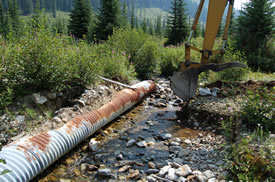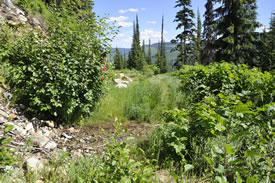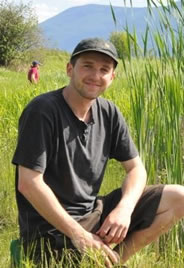Where the roads have no name: Road deactivation on the Darkwoods property

Culvert deactivation, Darkwoods, BC (Photo by NCC)
“Ok pickup truck, you’re good to go,” the crew chief calls over the radio. We cautiously crawl across the active logging site en route to Darkwoods, the Nature Conservancy of Canada’s (NCC's) vast conservation area in BC’s South Selkirk mountains. Today we manage to pass through without getting a branch stuck in our under-carriage, but are stopped at the exit by the haul-truck driver. He gets out of the cab with a fresh box of donuts, offering us one with a grin before we continue on our way.
Over the course of our two weeks doing field work on Darkwoods, my fellow conservation intern Roslyn and I have built a radio-rapport with this crew, whose operation we have to go through in order to access the south-eastern reaches of Darkwoods. Witnessing an active logging operation with feller/bunchers, skidders, loaders and processors all working in close synchronicity offers a glimpse at this area’s forestry heritage
While softwood lumber is a renewable resource we all rely on in one form or another, we must save some pockets of our vast forested land for non-human interests. I take comfort in knowing that NCC is working to ensure the vast majority of its 136,000-acre (55,000-hectare) piece of the South Selkirk landscape is free from motorized disturbance.
Motorized disturbance is not only caused by industrial machinery. Snowmobiles, ATVs and other recreational off-road vehicles are all sources of concern to Darkwoods' management team, who are seeking to protect sensitive riparian areas and native vegetation from the impact of these machines. Disturbance to wildlife is also an important consideration; the federal government’s designation of critical habitat for mountain caribou within Darkwoods stresses the need for safe, undisturbed calving sites for this engangered herd.

Road deactivation on Darkwoods, BC (Photo by NCC)
A crucial part of protecting Darkwoods from the impacts of motorized disturbance involves removing a large portion of the 450-kilometre network of logging roads left behind by the land’s previous owners. Road building, especially in steep terrain, can drastically alter a landscape by compacting the soil, diverting drainage, sedimentation, over-loading slopes and causing erosion, as well as aiding the spread of invasive plant species.
For this reason much of our time at Darkwoods has been spent prescribing road deactivation with project manager Dave Wickstrom. Many of the roads we visit have been abandoned for years and we must undo some of the natural reclamation that is already underway by removing patches of alder and birch just to gain access.
The irony is not lost on us, but if left to re-vegetate unchecked, these roads — many built before modern forestry standardization — can age poorly. We learn about the different treatments that will ensure a road’s smooth transition back to nature. These prescriptions mainly involve restoring natural drainage patterns and using excavator to reduce steep slopes at risk of slumping or sliding.
Another problem these deactivations may well address is the increased access these roads provide to high-elevation caribou range, a theory biologists have propounded to explain a spike in herd mortality in recent years. Mountain caribou rely on specialized, high-elevation habitat their fragile winter season which predators could not reach, especially in winter months. The advent of roads and snowmobile tracks into caribou habitat, the theory goes, has enabled animals such as wolves to follow a ready-made trail up to elevations, and prey, they could never previously attain. By eliminating the high-elevation roads, and the compacted tracks that can follow them, deep snow can once again serve as the natural defence these caribou rely on.
Following deactivation, these roads can be left to be reclaimed by the surrounding forest, much like what happens after a natural disturbance such as fire or flooding. Once this process is well underway, the only evidence of the land’s previous use is a slight irregularity with the surrounding slope, much like the traces of skid-trails still found in the bush many decades after their last use. Eventually the vegetation takes over the roads so completely they become quite impassible, eliminating intrusion by unpermitted vehicles.
While NCC limits motorized access to Darkwoods, it welcomes human-powered recreation in the less-sensitive parts of the conservation area. Hiking, climbing, skiing and accessing the Kootenay Lake waterfront are all possible on weekends, with a permit.
Tailoring a former industrial landscape as big as Darkwoods to a manageable conservation area has been a long and meticulous process for NCC. Five years of work in that direction had already taken place by the time we visited, and work will continue long after we've left. Road deactivation is only one part of that process, but it has been fascinating to learn more about it during my internship, as well as to witness firsthand the sheer magnitude and beauty of the area this project protects.


